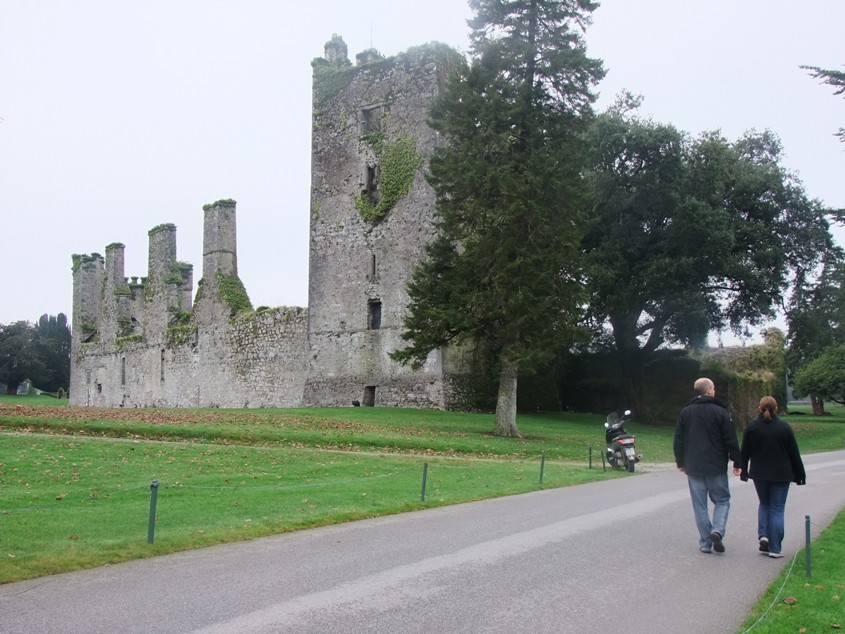Kieran’s Our City, Our Town Article,
Cork Independent, 12 November 2015
Cork Harbour Memories (Part 37)
The Gems of the Fitzgeralds
East Cork of the early 1600s possessed a number of old Fitzgerald family castles, which passed to Richard Boyle (1566-1643). John Speed’s map of c.1610, part of his collection of maps of Britain and Ireland from The Theatre of the Empire of Great Britaine (1611-12), showcases these structures within named territories of Irish and English lords. Three more sites are generally detailed below (continued from last week), whose ruins have survived into the modern day Irish landscape.
Ballymartyr Castle is marked on Speed’s map, which survives as a key attraction on the Castlemartyr Resort estate. The ruins of the impressive Boyle manor house, its exterior walls, chimneys, its bawn or enclosure wall, a mural tower, and a fortified house survive as well the five-storey tower house. The tower is quite possibly an earlier structure. The historical records for the site detail a chequered history but certainly there is a sense that there is much to still much to discover and interpret about its role in the formation of the layered histories of East Cork. It is known that the first castle was first built in 1210 by the Knights Templar under the leadership of Richard Earl de Clare, also known as Strongbow. By the mid fifteenth century, the castle was the seat for the local seneschal or steward of the regional Lord appointed by James, Earl of Ormond. Ballymartyr Castle was captured in 1569 by Elizabeth’s Lord Deputy of Ireland Sir Henry Sidney, when Ormond’s men abandoned the castle overnight after a cannon attack. Sidney had initially proposed the appointment of a military governor (Lord President) in the provinces of Munster and Connacht. This incited the first of the Desmond Rebellions led by James Fitzmaurice Fitzgerald of the Geraldine family. Ballymartyr was subsequently given to Sir Walter Raleigh, and later managed by local Elizabethan steward John FitzGerald. The Earl of Ormond attacked the castle in 1579. John FitzGerald was eventually captured in 1583 and died a few years later in Dublin Castle in 1589.
During the early seventeenth century, Richard Boyle, the first Earl of Cork, built a magnificent Manor House, whose exterior walled ruins are impressive to explore and circumnavigate. It is only when you stand by its walls that you appreciate how significant this court-like-castle would have been in the East Cork countryside showcasing a marker of a change in leadership and architecture in early seventeenth century Irish society. In the 1640s, the citizens of the castle again witnessed conflict and changed hands twice more before being set on fire to prevent it being used as a base for the Irish Confederate forces. During the civil war, the castle was captured by the Irish, and then recaptured by the Williamites in 1690, but was badly damaged and eventually abandoned and fell into disrepair. It was Henry Boyle (1682-1764), 1st Earl of Shannon and ancestor of Richard Boyle, who built the eastern portion of the present mansion house or hotel and who set about beautifying the estate between the years 1733 and 1764.
Located c. 3 miles west of Castlemartyr village in the parish of Ballyoughtera and the barony of Imokilly is Ballintotis Castle. Its proposed restoration in 2008 led to a request for an impact assessment to be prepared and a log in the great archaeology website, www,excavations.ie. It is a small square tower-house that was built as an outer defence for the Castlemartyr estate in the sixteenth century. The castle and lands were granted to George Moore in 1579 in gratitude for his contribution to the wars in Scotland and Ireland. The castle is included in the Down Survey of 1655 and the lands of ‘Killurgane and Ballytotis’ are listed as being the property of Edmund Fitzgerald at this time. The castle survives today as a small, standard four-storey tower-house.
Ballintotis Castle today is entered at ground-floor level by an arched door near the north end of the west wall. Part of a high rubble limestone wall survives to the west of the tower, which is interpreted as part of the original bawn wall or part of a former building which abutted the castle. The initial phase of monitoring for restoration focused on the removal of topsoil for a new driveway leading from the castle to the public road. All works associated with the insertion of services and the removal of waste from the tower-house were also monitored. Margaret McCarthy, the author of the detail on excavations.ie, details that during restoration no features of archaeological significance were identified on the surface and the finds consisted of three fragments of post-medieval ware.
Inchiquin castle of the Fitzgeralds is also marked on Speed’s map. It is one of the few round structured castles in County Cork. The walls are from 8-12 feet thick. In 1322 a document mentions it as a round tower built of stone. It was the property of the Fitzgeralds and was a dower house for widows of the Desmond family. According to legend, the Old Countess of Desmond lived here for 70 years and died in 1604 tradition says aged 140 (!). So myth from this time has also survived in the local folklore of the area which intertwines with the landscape. Walter Raleigh later owned this property in time and sold it to Richard Boyle.
To be continued…
Captions:
818a. Ruins of Richard Boyle’s early seventeenth century manor house at Castlemartyr Resort (picture: Kieran McCarthy)
818b. Section of East Cork from John Speed’s Province of Munster, from his The Theatre of the Empire of Great Britaine, c.1610-11 (source: Cork City Library)

